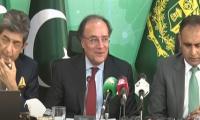It is apparent now that Project Imran Khan/PTI is being dismantled. Some commentators wonder whether the PTI was ever a political party. Others use the past tense for the PTI. Whether or not the PTI survives this phase or continues to wither away, it is certain that Project Imran Khan was only a manifestation.
Former finance minister Miftah Ismail says Pakistan is the worst governed country. The World Bank states Pakistan’s human development indicators are truly dismal, at the level of Sub-Saharan Africa and below the South Asian average. All of these are manifestations. The root cause, as I have said many times in these pages over the years, is the intra-elite tussle between the country’s political and non-political elite from end 1988 till recently. It has led to the logjam of governance.
In 1990, per-capita GDPs for India and Pakistan were almost identical: a little under $370 per person. By 2021, India’s per capita GDP was $2,277, approximately 50 per cent higher than Pakistan’s. This is around the same time in Pakistan when there was a return to democracy from late 1988 onwards after a long brutal dictatorship. Hence ensued the intra-elite tussle between the country’s political and non-political elite.
There were serious efforts to wipe the old political elite off the face of governing the country, and the PTI was only the latest instrument to achieve it. By contrast, there was no such existential tussle in India. Therefore, India prospered and Pakistan continued to regress as the non-political elite dominated but it could not entirely finish off the old political elite. Games of maneuvering and out-maneuvering kept on being played by both sides. There were short time-horizons when the political elite ruled. Hence, we have supposedly the worst governed country with depressing human development indicators.
In the article ‘Budget priorities for 2023-24’ (June 12), Dr Hafiz Pasha has written that the tax gap in Pakistan is equivalent to 3.0 per cent of the GDP – Rs2,500 billion. Much of this is in the form of the missing provincial taxes. Agricultural income tax comes first in this regard. Even if levied at half the urban income tax level it can fetch the government Rs320 billion. At present it only contributes Rs4 billion to the tax stream at the provincial level. The provincial boards of revenue need to upwardly adjust agricultural income.
Another area of ‘untapped’ taxation is “the taxation of properties and property developers in the form of the urban immovable property tax, income tax on rental income, capital gains tax on property transactions and capital value tax on properties,” according to Dr Pasha. At present, these taxes yield only Rs48 billion, while their true revenue potential is Rs520 billion.
The wholesale and retail trade sector is the third area that is under-taxed. Its tax yield is only Rs32 billion presently and it can go up to Rs270 billion by “expanding the coverage of the withholding tax on electricity bills and enhancing the fixed tax rates.” Progressive taxation can increase tax revenues by 12 per cent by adding the additional almost Rs1,000 billion to it.
There is a similar story with state-owned enterprises (SOEs) that have been hemorrhaging the economy for decades. Pakistan has given a subsidy of roughly Rs1,500 billion to SOEs this year. According to a World Bank report of 2021, Pakistan has spent in the range of 8-12 per cent of its GDP on subsidizing SOEs in recent years. Why can’t Pakistan privatize or close down the loss-making monumental SOEs?
There is a governance logjam in the country due to the tussle between the political and non-political elite. There was an effort to privatize Pakistan Steel Mills in the past that was duly aborted due to the excessive intervention of the judiciary in the economic matters of the country in the past.
The federal government is bloated. Both Dr Shahid Kardar and Dr Hafiz Pasha have pointed towards it. There are 35 ministries and hundreds of autonomous bodies and attached departments. Much of it should have been devolved to the provinces post the 18th Amendment, but this has not been the case. Why? This is due to a logjam of governance. The power sector’s circular debt has reached Rs2.67 trillion. It has been ballooning over the decades. Some governments in the past reduced it to some extent, but it catches up again and again. Why has this problem not been resolved? Due to a logjam of governance.
It is not that some of the recent finance ministers such as Ishaq Dar, Miftah Ismail, Shaukat Tarin, and Hafeez Shaikh or the provincial finance ministers and the chief ministers cannot grasp these realities or implement them. All of them understand these points pretty well. The real reason why these progressive taxation measures are not implemented are the political economy considerations.
With short time-horizons and with the fear of being extinguished from politics, the political elite does not want to take these measures as they entail political cost and would make the political governments unpopular.
According to the World Bank’s recent report, Pakistan’s Human Capital Index (HCI) measuring human development in the country is 0.41, while the South Asian average is 0.48. Bangladesh’s HCI is 0.46 and Nepal’s 0.49. Pakistan resembles Sub-Saharan Africa more in its human development (whose HCI is 0.40) than South Asia.
A child born in today’s Pakistan will only be 41 per cent productive compared to if s/he were given a chance to enjoy full education and complete health. Why does Pakistan lag so far behind in human development and welfare of its citizens? A logjam of governance.
The old political guard of the PML-N and the PPP signed the Charter of Democracy in 2006 and pledged to work together and remain largely independent of the influence of the non-political elite. Project Imran Khan was conceived as a reaction to it to create a third force in the country and get rid of the old political elite that claims to refute the hegemony of the non-political elite. This project was formally launched in 2011 and the rest is history. It led to the lost decade of development and growth for the country due to the tussle between the political and non-political elite.
The good news is that there is light at the end of the tunnel. Things have been changing since post end-November last year. The non-political elite and the old political elite seem to be getting along rather well. The old political elite has learnt not to get confrontational with the non-political elite and the latter has also learnt mutual co-existence. One hopes the trajectory of accommodation continues. However, it is important to analyze the cost of the intra-elite tussle in the last 34 year for the country and its people so that a regime of political stability can take roots in the country for the foreseeable future.
Progressive taxation and other critically needed governance and human development reforms can only be implemented if political governments are sure that they will not be booted out of politics and their rule not overturned through backdoor tactics. For that, all elite factions – political as well as non-political – need to agree to certain rules of long-term engagement for the next 10-20 years to ensure political stability.
The writer is an Islamabad-based social scientist. She can be reached at: fskcolumns@gmail.com
Contributions of countless other women go unnoticed and unacknowledged year after year
Joyous gatherings, poetic expressions, and cultural rituals that revolved around water are now echoes of distant past
Most lawyers expect massive backlash within Supreme Court, reaction was far more muted than anticipated
Government is determined to unleash full power of Reformistan’s economy and pave way for unprecedented growth,...
We might begin, as Changchun-of-old did, by stating obvious: what is, does not work
Country is deeply divided, and this fragmentation cannot be addressed through symbolic actions or occasional...







